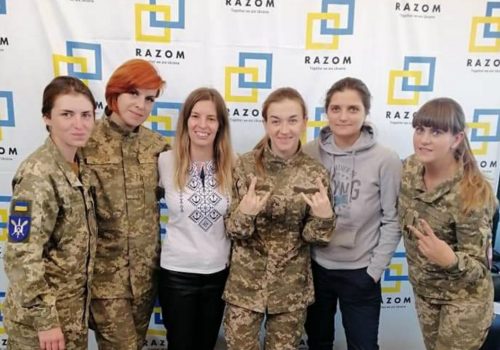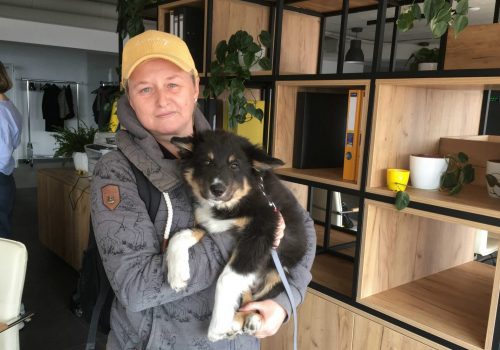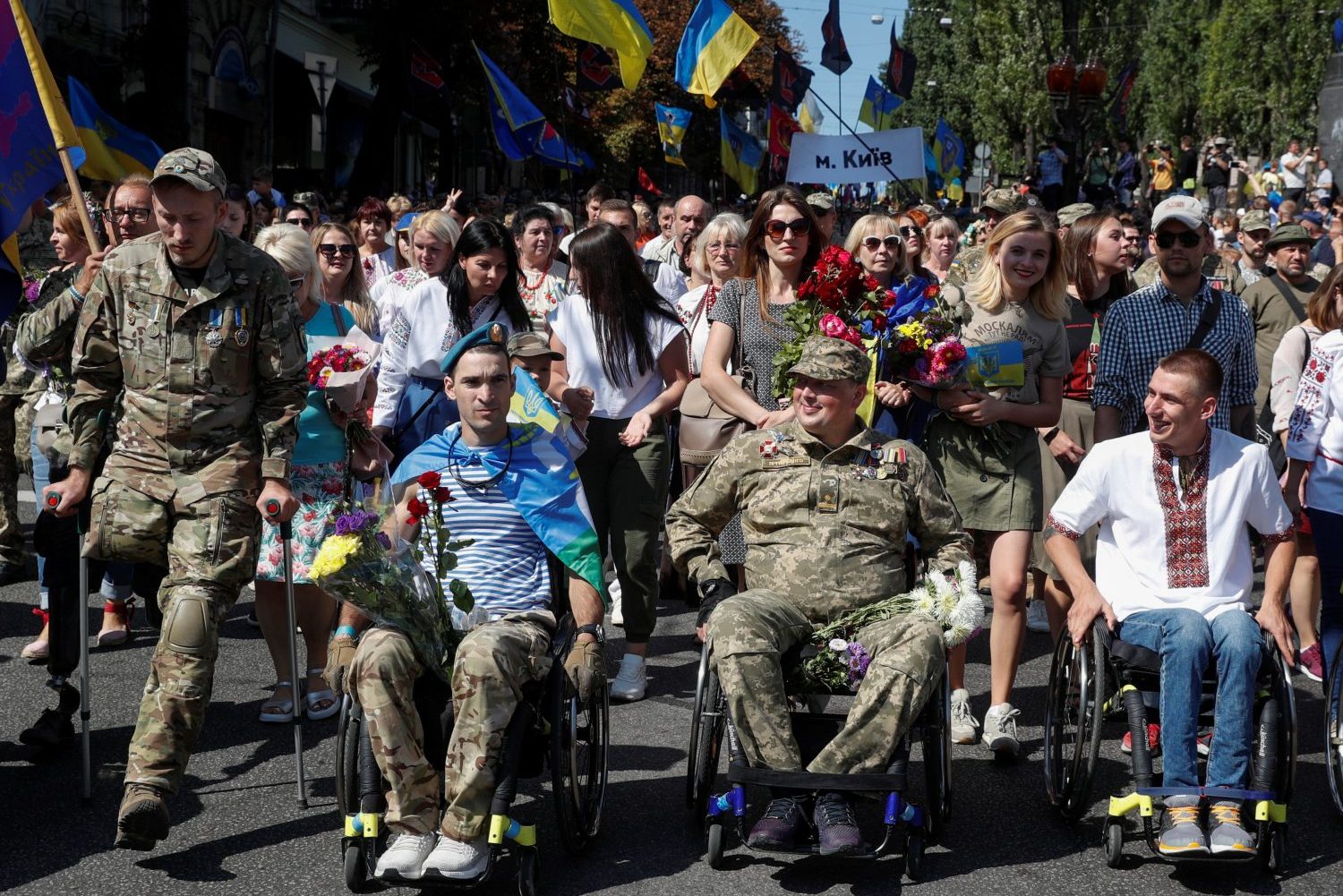The trip from Donbas: Ukraine’s pressing need to defend its veterans
Want to read this report offline?
The war in the Donbas is entering its sixth year no less violent, and no closer to a peace agreement, than when it began. When Russia invaded in 2014, the Ukrainian army was wholly unprepared. Many officers were corrupt, had long-standing relations with the Russian military from their days in the Soviet army, and lacked combat experience.1David Marples and Myroslava Uniat, “The Ukrainian Army is Unprepared for War, ” Open Democracy, August 6, 2014. Maidan revolutionaries became volunteer soldiers, and private-security-turned-militia groups sped to the front to stop the Russia-led separatist offensive. Six years later, Ukraine struggles to care for and reintegrate the 385,000 Donbas veterans and volunteer combatants, thirteen thousand of whom are legally disabled.2Statistics provided by Deputy Minister of Veterans Affairs Oleksandr Tereshchenko at a presentation on Capitol Hill, Washington, DC, March 11, 2020. A lack of support for veterans creates a critical void in Ukraine’s national security and hobbles its transition to democracy.
Ukraine’s new Ministry of Veterans Affairs (MVA) consolidates approximately twenty disparate social services for veterans. With its establishment, politicians and civil society leaders agree that the country needs a comprehensive strategy for veterans care. The lack of care exacerbates several crises confronting veterans, including high rates of suicide, under- and unemployment, divorce, and domestic violence.3Ilia Ponomarenko, “Stress, Neglect Take Deadly Toll on Donbas Veterans,” Kyiv Post, May 4, 2018, https://www.kyivpost.com/ukraine-politics/stress-neglect-take-deadly-toll-donbas-veterans.html; “Cooperation for Cutting Domestic Violence,” United Nations Population Fund, February 7, 2020, https://ukraine.unfpa.org/en/news/cooperation-combating-violence. It also leaves them alone to counter disinformation targeted at veterans by Russia. They are also vulnerable to recruitment by right-wing and oligarch-sponsored security services, as they seek employment and to recreate the unit solidarity of the front.4Kimberly Martin and Olga Oliker, “Ukraine’s Volunteer Militias May Have Saved the Country, but Now they Threaten It,” War on the Rocks, September 14, 2017, https://warontherocks.com/2017/09/ukraines-volunteer-militias-may-have-saved-the-country-but-now-they-threaten-it/. An unfit veterans support network that provides little care risks veterans’ political and social disaffection, declining levels of recruitment and retention for the military, and the fracturing of families.
Setting up a responsive veterans care system furthers Ukraine’s democratic transition. Citizen soldiers make up half of the army’s recruits. Architects, engineers, teachers, accountants—citizens from all walks of Ukrainian life—enlist on a regular basis for time at the front. The Ministry of Veterans Affairs needs to reinforce Ukraine’s emerging democratic political culture that honors citizen service and places constituent needs at the heart of governance.
Care and protection for Ukraine’s veterans is also in the strategic interest of the United States, the European Union, and NATO, which seek a peaceful, stable, and undivided Europe. NATO continues to support Ukraine’s efforts to bring its security and defense sector closer to Alliance standards and practices, including strengthening civilian control and democratic oversight over the sector, improving planning and budgeting processes, and reforming the nation’s security services.
Reform of Ukraine’s veterans policies bolsters NATO efforts by providing a roadmap for civilian oversight of veterans affairs and security service reform in the form of post-deployment transition and reintegration support for soldiers. A robust, comprehensive veterans support program aids recruitment and retention, leading to a stronger Ukrainian military more prepared for its combat operations in the east—a war whose outcome will determine European security for decades.
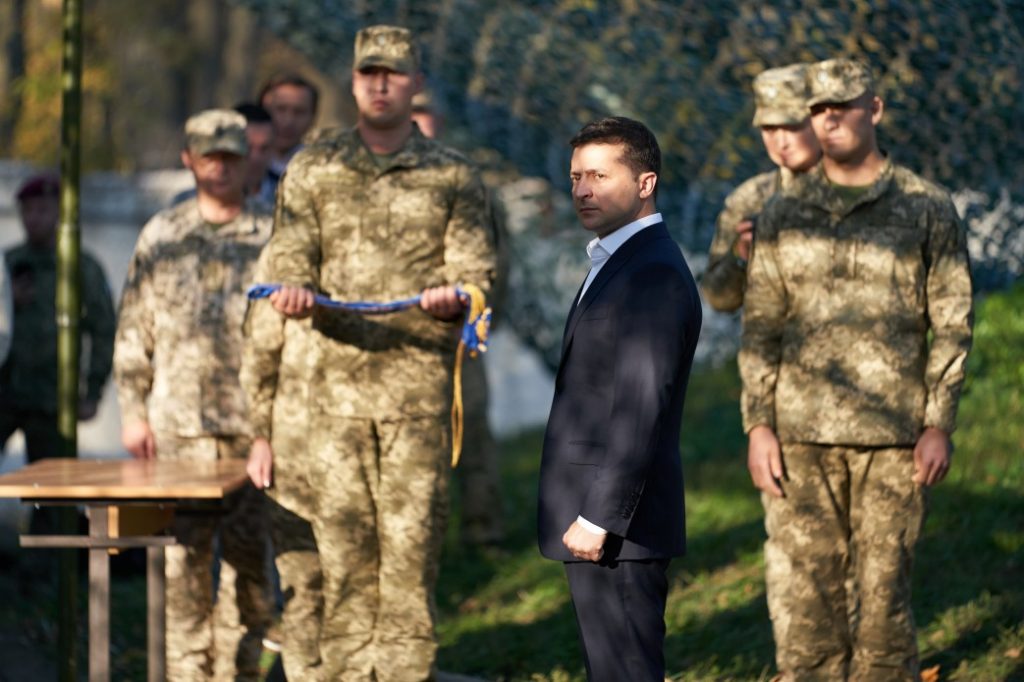
Six years later, Ukraine struggles to care for and reintegrate the 385,000 Donbas veterans and volunteer combatants, thirteen thousand of whom are legally disabled.”
President Volodymyr Zelenskyy attends an event on Defenders of Ukraine day, October 14, 2019. Source: President of Ukraine
Veterans and politics
Ukraine is in a struggle for existence as a sovereign, democratic state on two fronts: along the contact line in the Donbas and in the halls of government. This struggle pits the “old system”—the corrupt, oligarchic, and Soviet-nostalgic classes that remained after communism—against “new Ukraine’s” citizens and civil society, who envision their country as a modern, democratic, European state. Ukraine’s veterans return home from fighting Russian troops and their proxies only to confront the effects of this political struggle—bureaucratic blight and political in-fighting that can victimize or manipulate veterans as a group. Increasingly, they are tarred by disinformation and negative media coverage emanating from Russia and from powerful Ukrainian political forces, disinformation that undermines public support for veterans and their access to essential services.
Veterans of the Donbas war also have false allies to worry about. While veterans struggle to organize, powerful political groups have attempted to co-opt their issues and funding. Prior to the war, veterans received subsidies from the Ministry of Social Policy in a system that was more Soviet than reformed. The initial push for a Ministry of Veterans Affairs came from the Rada’s Committee on Veterans, Combatants, and Participants in the Anti-Terrorist Operations. The committee’s chairman, Oleksandr Tretyakov, was a political maneuverer opposed by many veterans who saw a corrupt class angling for control of veterans issues and associated funding streams.5Lauren Van Metre, “Ukraine’s Veterans are a Powerful Constituency: Who Will Control Them?” UkraineAlert, Atlantic Council, Thursday, June 7, 2018, https://www.atlanticcouncil.org/blogs/ukrainealert/ukraine-s-veterans-are-a-powerful-constituency-who-will-control-them/. Late in his administration, in 2018, then-Ukrainian President Petro Poroshenko established a shell of a Ministry of Veterans Affairs (MVA)—a small team with a mandate, but no funding—a move aimed at boosting his electoral campaign.6Interview with Sheri Michel, former Senior Medical Advisor, Ukraine Ministry of Defense and Ministry Veterans Affairs, January 31, 2020. The first minister of the MVA, Iryn Friez, was a Poroshenko loyalist with no expertise in veterans affairs.7Illia Ponomarenko, “New Minister, New Ministry: Will Veterans Notice?” Kyiv Post, January 18, 2019. https://www.kyivpost.com/ukraine-politics/new-minister-ministry-will-veterans-notice.html.
In the first few days of Ukrainian President Volodymyr Zelenskyy’s administration, survival of the MVA appeared tenuous.8Askold Krushelnucky, “Ukraine Examines New Method to Spot Post Traumatic Stress Disorder,” Kyiv Post, August 24, 2019. https://www.kyivpost.com/ukraine-politics/ukraine-examines-new-method-to-spot-post-traumatic-stress-disorder.html Eventually, the new president combined it with the Ministry for Temporarily Occupied Territories and appointed Oksana Koliada, a former reserve colonel with service at the front, to lead it. Friez and Koliada received good marks from veterans for their efforts to dismantle Soviet-era veterans subsidies, and replace them with internationally recommended benefits and care programs. But in a cabinet shake-up in March 2020, Zelenskyy replaced Koliada with Serhiy Bessarab, a former Soviet and Ukrainian military officer whose last assignment was deputy chief of the general staff. Many veterans and activists on their behalf saw the move as a reassertion of the “Soviet old guard,” which puts bureaucratic interests over those of citizens and soldiers.9“Who’s Who in Ukraine’s New Cabinet of Ministers,” Kyiv Post, March 4, 2020. https://www.kyivpost.com/ukraine-politics/whos-who-in-ukraines-new-cabinet-of-ministers.html. Bessarab’s appointment also solidified the authority of the professional military over the MVA, which until then had been dominated by leaders of volunteer units.
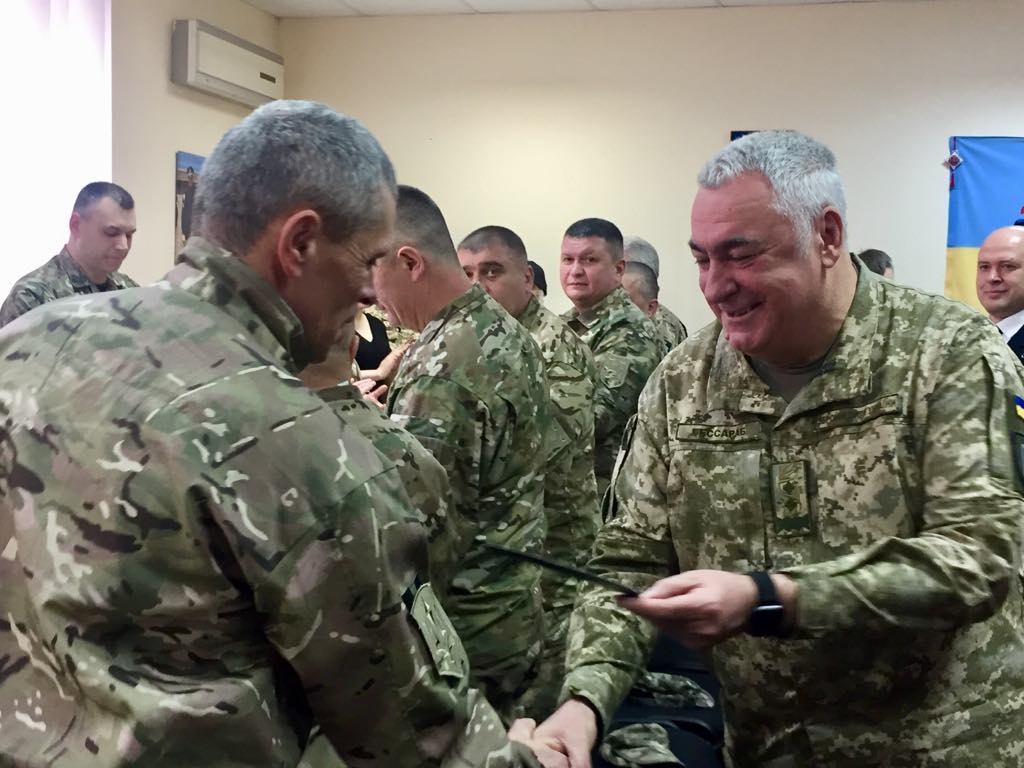
Serhiy Bessarab greets a representative of Ukrainian volunteer divisions, 14 March, 2020. Source: Ministry of Veterans Affairs
Veterans, who tend to be influential and vocal critics of Zelenskyy’s peace overtures, are concerned that the president is using the existence of a ministry and much-needed benefits to silence them.10Interview with Yana Zinkevych, Veteran, Founder of the Hospitalier Battalion, Member of the Parliament of Ukraine, March 13, 2020, Washington, DC. If they do not blunt their political organizing and advocacy they worry that the administration could neutralize, or even eliminate the MVA by reincorporating veterans policies and services under the Ministry of Social Policy, which would effectively downgrade support for veterans even as their numbers and needs expand.11Ilya Lysenko, Medical ATO Hospitaller, Interview, March 13, 2020, Washington, DC.
The issue of who is and is not a Donbas veteran is highly politicized. During the initial weeks of Russia’s invasion, as the Ukrainian army struggled to respond, civilians from the Maidan, volunteer soldiers, and veterans of the Afghan war rushed to the front to prevent its collapse. For Ukrainian citizens, the heroism of those volunteers rested on a proud tradition of citizen self-defense combined with the current civic volunteerism movement central to Ukraine’s post-independence national culture. Despite the sacrifice by volunteers at the front, they became less popular in part due to Russian disinformation casting them as right-wing fascists, widespread distaste for their oligarch sponsors, and their ambiguous, and sometimes fraught, relationship with the Ukrainian government and military, both of which were gaining stature as the war continued.12Anna Bulakh, Grigori Senkiv, Dmitri Teperik, First on the Front Line: The Role of Volunteers in Countering Russia’s Military Aggression with Ukraine, International Centre for Defense and Security Report, August 2017. https://icds.ee/first-on-the-front-lines-the-role-of-volunteers-in-countering-russias-military-aggression-against-ukraine/. The political tensions surrounding the volunteer units affected their post-deployment status. It was not until December 2019, when Zelenskyy signed a law granting them combatant status, that volunteers had access to veterans benefits.13“Zelensky signs law on combatant status to volunteer soldiers,” Ukrainform, December 24, 2019. https://www.ukrinform.net/rubric-polytics/2844393-zelensky-signs-law-on-combatant-status-to-volunteer-soldiers.html
The veterans of the Donbas war join several generations of Ukrainian veterans from the Soviet Union’s invasion of Afghanistan, Soviet proxy wars, and the Great Patriotic War, or World War II. The interests and needs of these other 415,000 veterans differ significantly.14Presentation by (then) Deputy Minister of Veterans Affairs Oleksandr Tereshenko, March 11, 2020, Embassy of Ukraine, Washington, DC. Each faction also has satellite groups invested in its agenda. For example, while there are fewer living WWII veterans, some civil society groups sustain themselves by memorializing WWII veterans’ sacrifices through ceremonies, civic programs, etc.15Skype Interview with Ella Lamakh, Head, Democracy Development Center, February 8, 2020. Veterans of the Afghan war have been recognized for their role in the Maidan, putting themselves between protesters and police to prevent violence, before categorically taking a side by volunteering at the front to rebuff the Russian invasion. Many dual veterans of Afghanistan and Donbas still maintain ties to compatriots in the countries of the former Soviet Union abroad who also served in the Soviet army. Meanwhile, different constellations of Donbas veterans express varied needs; irregular volunteers want to maintain unit ties, while veterans of the regular army tend to prioritize their post-service transition, such as employment and education.16Skype Interview with Vitaliy Deynega, Head, Come Back Alive, February 4, 2020. The Ministry of Veterans Affairs has been challenged to mediate these competing interests given limited funding and the lack of a strategic approach that would establish clear priorities.17Skype Interview with Ella Lamakh, Head, Democracy Development Center, February 8, 2020.
A complicated legacy
After the collapse of the Soviet Union, the Ukrainian government spent decades shrinking the military and providing benefits to military retirees and dwindling numbers of Soviet-era veterans. With Russia’s invasion of Crimea and the Donbas, however, the military rapidly built back up its corps of combat troops, with a corresponding rise in the numbers of wounded and demobilized combatants.
Ukraine’s response to this crisis has echoed the Soviet Union’s approach to Afghan war veterans in the 1980s—national policies that shift responsibility, but little to no resources or capacity, to local leaders; a focus on cash payments rather than social services; and an overly bureaucratic and fragmented system that puts the onus on veterans to wrestle with the state for assistance.18Natalia Danilova, “Veterans’ Policy in Russia: A Puzzle of Creation,” The Journal of Power Institutions in Post-Soviet Societies Special Issue: The Social and Political Role of War Veterans, Issue 6, no. 7, 2007, p. 1-11. https://journals.openedition.org/pipss/873. And just as Russian nongovernmental organizations (NGOs) in the 1990s had to tend to veterans’ needs because of state institutional weakness and corruption, Ukraine’s contemporary volunteer movement fills the gaps in veterans services. Most of these civil society organizations are altruistic and upstanding, but oligarch-sponsored NGOs do exist, siphoning off funds for veterans to enrich corrupt actors and politicians. Many small organizations claim NGO status and demand funding only having helped one or two veterans. This fractured, inexperienced, and occasionally corrupt civil society support for veterans is noble and essential, but problematic. Unable to determine whether an organization is legitimate, donors often avoid funding veterans programs.19Skype interview with Ella Lamakh, Head, Democracy Development Center.
Veterans support: A hybrid system
The current veterans support system is partially Soviet and partially reformed. It is in theory managed by the new ministry, but it has in fact been caught up in Ukraine’s major shift of power to local governments, which inconsistently fund and implement veterans programs. The system is held together by civil society and Ukraine’s robust volunteerism. It is a jigsaw puzzle with missing bits, plus pieces from other puzzles. It needs a strategic direction and rationale and a massive infusion of resources, applied in ways that consolidate that strategy and do not further fragment veterans care.
Until Poroshenko established the MVA in 2018, the Ukrainian government’s support for its veterans was divided across twenty departments and focused primarily on financial payments, access to the country’s sanatoria system, free or discounted public transportation, and funds for housing.20These include local municipal authorities, local executive authorities, the State Service for Veterans Affairs, the Social Security Fund for the Disabled, Ministry of Health, Ministry of Social Policy, Ministry of Defense, Ministry of Internal Affairs, Ministry of Infrastructure, Ministry of Regional Development, Security Service of Ukraine, Foreign Intelligence Service, State Emergency Service, State Border Service, State Border Guard Service, State Service of Special Communication, National Guard, State Fiscal Service, State Special Transport Service, Pension Fund of Ukraine, State Service of Ukraine for Geodesy, Cartography, and Land Cadastre. The legacy of a Soviet-style bureaucracy, designed to reinforce stasis and quash independent decision-making, continues to hamper veterans’ access and care. Veterans struggle to get information and endure an onerous process to access most assistance.21Conflict in Ukraine: Socio-Economic Impacts of Internal Displacement and Veteran Return, World Bank Summary Report, May 2017, http://documents.worldbank.org/curated/en/571011497962214803/pdf/116489-REVISED-Updated-Report-Socioeconomic-Impacts-Internal-Displacement-Veteran-Ret.pdf. For example, those who have lost limbs have to validate every year that their injury still exists.22Interview with Tonya Kumka, President of Kohorta, a Canadian NGO dedicated to buying prosthetics for Ukrainian veterans, November 9, 2018. In some cases, the specific financial assistance available does not meet veterans’ needs, such as public transportation stipends for veterans in rural areas.
Ukraine’s national healthcare and employment systems, through which veterans receive access to medical treatment and job support, are not always tailored to the needs of veterans, nor do they prioritize veterans’ access. To fill the gap in veterans services (healthcare and rehabilitation, community reintegration and social support, family support, employment and skills training, and women veterans affairs), volunteer and civil society groups are working together and with the state. However, these groups recognize that their support is mostly altruistic and they lack the requisite skills and professional training.
To address some of these issues, Zelenskyy’s first appointee to lead the MVA, Oksana Koliada, set out the following goals:
- With the Ministry of Health, define the principle medical needs of veterans, open specialized institutions for veterans under the jurisdiction of the MVA, and simplify veterans’ access to healthcare institutions under the Ministry of Health through a veterans registration system.
- Create a psychologists’ training center to increase the number of primary psychological aid specialists and introduce mobile field groups in the regions.
- Establish five regional one-stop rehabilitation centers to aid psychosocial adaptation and offer career guidance, legal advice, and training and education programs.
- Create a single register of veterans and an electronic services provision system accessed through a veteran’s personal account.23Five-month interim report of the Ukrainian Ministry of Veterans Affairs, February 2020.
The Ministry of Veterans Affairs under its first two leaders, Poroshenko appointee Iryn Friez and then Koliada, won praise for its willingness to engage with veterans and civil society. For example, the MVA went beyond a government mandate for all ministries to establish public oversight councils to set up a veterans council, consisting of veterans elected from around Ukraine.24Skype Interview with Vitaliy Deynega, Head, Come Back Alive, February 4, 2020. Newly appointed Minister Bessarab has given no indication that the Ministry will pursue this reform package which is supported by veterans in Ukraine and corresponds to Western standards of veterans care.
Veterans services at the local level prove that necessity is the mother of invention. Ukraine’s decentralization reforms push funding and government services, including those for veterans, closer to citizens. In many ways, this is appropriate, but benefits mandated by the federal government are not always backed by resources to provide them, forcing local governments to be creative and adaptive. For example, a national law gives veterans and families of deceased or disabled soldiers priority in the allocation of state-owned and allocated land. The execution of this law, however, was left to regional and municipal governments, some of which had land to give, and some of which did not. Thus, a veteran receives land based on its availability and on the political will of the local authority. In some cases, governments gave veterans plots that were uninhabitable, unsellable, and non-arable. In Poltava, thousands of soldiers have received land. In Lviv, veterans receive money in lieu of land unless they opt for a plot far from the city.25ЮРИДИЧНА СОТНЯ, “Забезпечення потреб учасників російсько-української війни на місцевому рівні,” 2017.
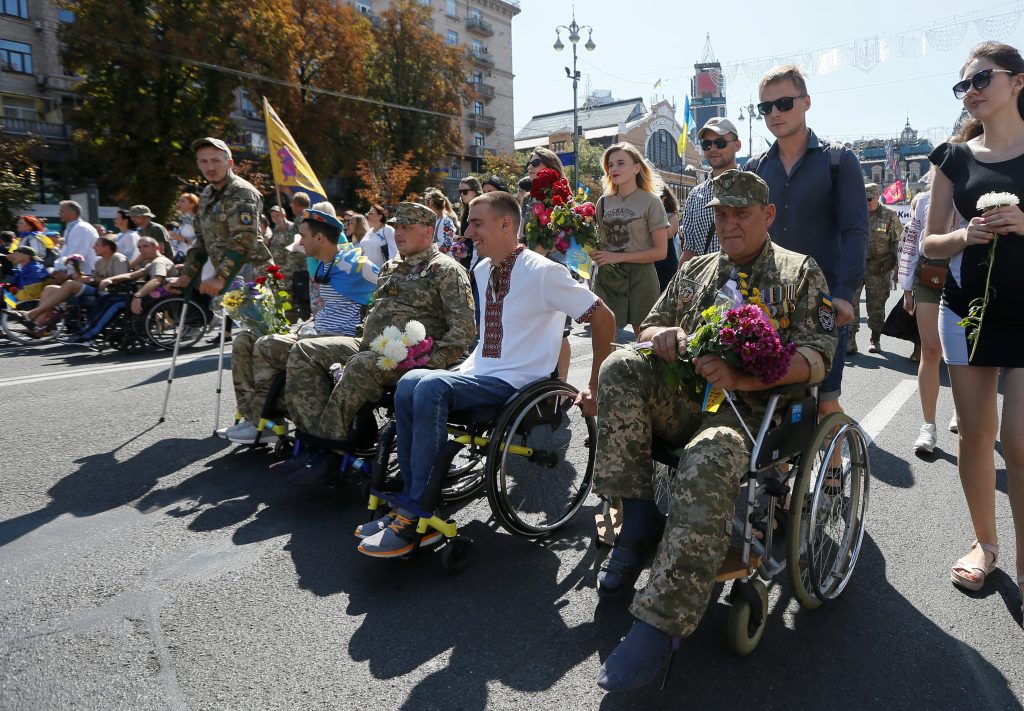
While local communities are stepping up, often in inventive ways, their efforts are no substitute for a national strategy and a comprehensive approach.”
Ukrainian veterans take part in the March of Defenders of Ukraine as part of Ukraine’s Independence Day celebrations, in Kyiv, Ukraine August 24, 2019. REUTERS/Valentyn Ogirenko
Similarly, medical services for veterans are guaranteed by federal law, but rarely is enough funding provided to local entities.26Ibid. A few cities have been clever here. Vinnytsia pays into a veterans insurance program, which reimburses veterans for medical visits. In Ivano-Frankivsk, all local medical clinics have a special window for veterans’ treatment.27Ibid.
As for employment reintegration, the national government has no strategy, policy, or programs, so local communities address this need in their own ways. In Volyn, Ternopil, and Lviv, veterans receive loans from the local government to start their own businesses.28Ibid. In Kherson, ex-combatants are tapped and trained to patrol cities, towns, and border areas to provide community security.29Ibid.
The MVA and the Ministry of Defense (MOD) operate regional hospitals for soldiers and veterans that are funded locally. Under Ukraine’s new healthcare reform, veterans can access healthcare either through MVA- or MOD-operated hospitals, or civilian hospitals, which are reimbursed by the government for any veterans care they provide. The MVA would like to keep its regional hospitals, but their quality of service varies, with many more expert at geriatric care for older veterans than at serving those returning from the frontlines. Some regional sanitoria are also emerging as expert in veterans’ rehabilitation. An audit needs to be conducted of all MVA-run and operated institutions, including their finances, capacity, and rehabilitation and healthcare methodologies to determine whether they can deliver an appropriate level of care, or whether Ministry of Defense or Health institutions are better situated for veterans care.30Interview with MP Lesia Vasylenko, April 21, 2020.
While local communities are stepping up, often in inventive ways, their efforts are no substitute for a national strategy and a comprehensive approach. Benefits for veterans are locality-dependent, contributing to the patchwork system of support that exists today—a system where civil society and volunteers fill the gaps.
An uneasy welcome home
The weak state of psychosocial support and rehabilitation services
The most gaping need for Ukraine’s returning soldiers is access to psychosocial support. Incidents of combat-related psychological and brain trauma, domestic violence, substance abuse, and suicide among veterans are on the rise. In fact, Ukraine’s sky-high rate of suicide among veterans is a national crisis. It is here that Soviet psychology and mental health legacies have been most pernicious. Political dissent in the Soviet Union was attributed to mental illness; psychiatrists readily offered the authorities the requisite diagnosis and consigned dissidents to psychiatric hospitals where they were tortured, drugged, and experimented upon.31Denis Ougrin, “Psychiatry in post-Communist Ukraine: Dismantling the Past, Paving the Way for the Future,” Psychiatric Bulletin, December 2006, p. 456-459. People who were genuinely mentally ill were institutionalized as part of systematic discrimination against “unproductive” members of society. Routine therapy and outpatient treatment were not available due to the system’s stigmatization of mental illness and its over-reliance on psychiatric institutions.32Ibid. As a result, Ukrainians are still not culturally open to psychiatric therapy. Admitting to depression, anxiety, nervous disorders—any mental illness—is taboo. While Ukraine’s mental health community is adopting Western practices, the field remains small and centered on psychiatric hospitals and pharmacological interventions. Ukrainian psychologists often give mental health support to veterans but do not have the appropriate expertise, as psychologists are not medically trained. Western organizations often provide them short training courses, but there is little follow-up to determine if lessons are appropriately applied.33Interview with Dr. Darren Holowka, Psychologist, Ukraine American Veterans, Embassy of Ukraine, Washington, DC, March 11, 2020. Even more troubling are the swindlers peddling untested New Age methods for large fees, or Western psychiatrists promoting outdated approaches, such as Freudian “talk therapy,” when newer cognitive-behavioral methods have proved far more effective for treating post-traumatic stress disorder and other combat-related mental illnesses.
As important as post-combat mental health is prevention. Soldiers and their families should receive pre-deployment psychiatric assessments, and mobile psychiatric units should accompany soldiers to the front, as is done in Western armies. The area of psychosocial support is critical and must be top priority for the MVA, the Ukraine universal healthcare system, and the international community.
Occupational and physical therapy are new professions in Ukraine, and a lack of rehabilitation services has significantly slowed veterans’ recovery and reintegration. Further complicating rehabilitation services to veterans is the military’s simplistic evaluation system that categorizes wounded and disabled as moderate, medium, or severe.34Interview with Sheri Michel, former Senior Medical Advisor, Ukraine Ministry of Defense and Ministry Veterans Affairs, January 31, 2020. Veterans are never reevaluated after an initial diagnosis, and mental disabilities are never screened for, leaving even the few former combatants who have access to it without proper, targeted care.35Ibid.
To supplement an inadequate support system, one organization is pioneering the public-private partnership in Ukraine, working with state-run sanatoria throughout Ukraine to provide comprehensive rehabilitation programs. The Union of Participants and Veterans of the Anti-Terrorist Operation (ATO), or Suviato, was founded by three women who protested on the Maidan and drove loads of volunteered equipment to Ukrainian soldiers at the front.36The managers of Suviato are Oksana Andriyenko, Olha Kharkina, and Tetiana Skrypchenko. These days, they run social events for veterans receiving inpatient medical care as well as finding housing for veterans’ accompanying family, and employment, training, and housing when veterans are released. Suviato’s founders hope this new way of interacting with the Ukrainian state will become a model for other organizations without falling into the trap of having to provide services that are more appropriately left to the government.
With benefit payments constituting the primary basis of the veterans support system, and without a comprehensive reintegration program, many veterans return from the front “unrooted,” without stable employment and unsure of their position within their families and the community. They can also miss the status and sense of belonging that they enjoyed while serving. This sense of isolation makes them vulnerable in many ways: They might reenlist in the army or its newly integrated militias because they lack commensurate employment options; they might become alienated and unemployed; or they might even take their own lives. The government of Ukraine needs to prioritize veterans’ successful transition to productive civilian life not just as a practical matter—limiting the burden on state services and protecting recruitment efforts from the specter of a legion of maladjusted veterans—but also as a moral issue. A robust, effective and holistic reintegration approach is the least veterans deserve from the state they are protecting.
War, veterans, and gender
The Maidan not only forced regime change in Ukraine and a realignment with Europe, but it also made the country’s gender disparities harder to ignore.37Lauren Van Metre and Steve Steiner, “Building Gender Equality in Ukraine,” US Civil Society Working Group on Women, Peace and Security Issue Brief, June 1, 2017, https://wiisglobal.org/wp-content/uploads/2014/01/US-CSWG-Policy-Brief-Building-Gender-Equality-in-Ukraine.pdf. The Revolution of Dignity saw women take leadership roles and carry out risky and dangerous jobs, such as medics and security officers. When Maidan protesters headed to the front to fight, Ukrainian women volunteers operated drones, ran supplies, tended to the wounded, drove ambulances, and served in combat positions, including as snipers and in the infantry.38Yevheniya Oliynyk, “Ukraine Women at War: From Women’s Sotnya to Invisible Battalion,” Euromaidan Press, December 12, 2015. http://euromaidanpress.com/2015/12/10/ukrainian-women-war-womens-sotnya-invisible-battalion. Women served in both the Ukrainian military and volunteer battalions. In the process, they experienced sexual harassment on the frontlines and faced sexual discrimination upon their return home.39Interview with members of the Ukraine Women’s Veterans Movement (Andriana Susak-Arekhta, Yulia Semihailova, Kateryna Lutsyk, Yuliia Mykytenko, Olena Maksymenko, Mariia Berlinska), October 10, 2019, Chevy Chase, Maryland.
Many women soldiers were criticized for leaving their children and families to serve, stereotyped as sexually promiscuous, or even investigated by social services and had their children taken away.40Interview with members of the Ukraine Women’s Veterans Movement, October 10, 2019; Interview with Mariia Berlinska, Head, Invisible Battalion, July 4, 2018, Kyiv, Ukraine. The discrimination is often so bad that women veterans will not wear uniforms. Women are encouraged to ignore their trauma. As one female volunteer put it, “Men go to the pubs with other men, but women must get back to their jobs and take care of their children.”41Interview with Mariia Berlinska, July 4, 2018. Women veterans often feel isolated by societal expectations of them and by the lack of any support network specifically for women.42Ibid. Members of the Ukraine Women’s Veterans Movement estimate that the divorce rate for women soldiers is close to 70 percent due to time at the front and the lack of support post-deployment. Many of the women who served at the front were volunteers who were not granted rights to veterans services until the end of 2019. Because of legal prohibitions on women serving in combat roles, many were designated as field support and were denied access to combat health services.43Interview with members of the Ukraine Women’s Veterans Movement, October 10, 2019. Women veterans are reluctant to raise their voices, fearing that their criticisms of the armed forces and war service will be weaponized by Russian propagandists, undermining the very effort they sacrificed to support.
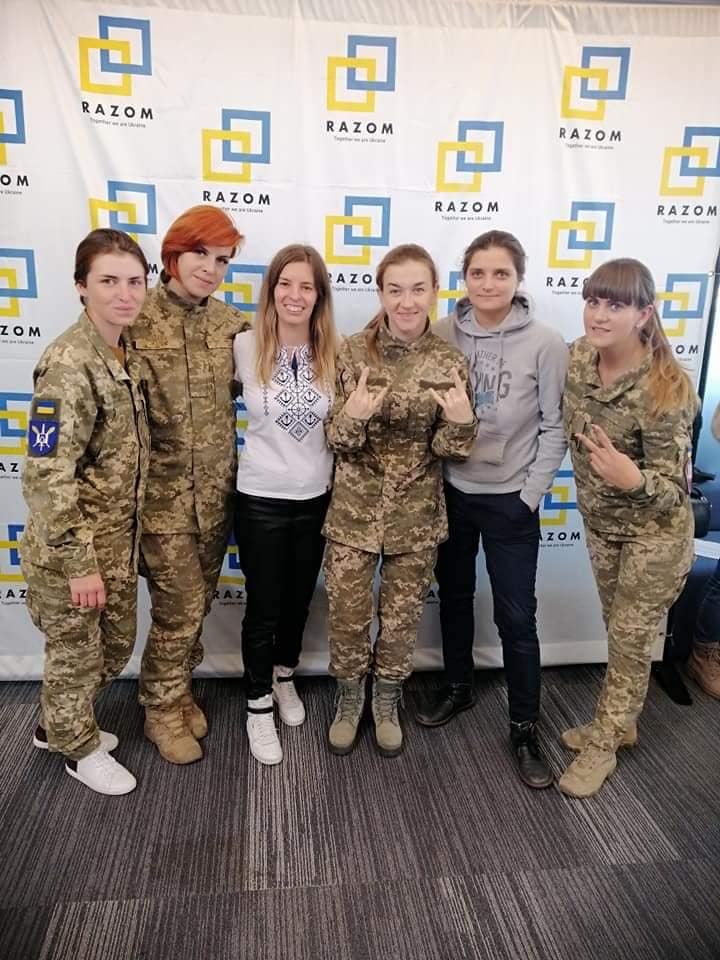
Woman warrior: Mariia Berlinska
In 2014, as a volunteer at the front, Mariia Berlinska operated drones for several military units, including Aidar. When Maria returned from the front she opened the Ukrainian Center for Drone Intelligence to train civilian volunteer drone operators, and to collect money to buy more UAVs. When the Army took over many of the volunteer operations, Mariia became a political warrior, investigating the situation of women veterans in a ground-breaking documentary and report Invisible Battalion. Her report drove fundamental gender reform in the Armed Forces. Based on her work, the Rada’s Equal Opportunity Caucus introduced a bill that guaranteed equal access to military postings and ranks, the same retirement age, and the same requirements and conditions for military assignments. Berlinska shows how despite negative societal perceptions veterans contribute to Ukrainian society. In fact, their combat experience can make them more desirable as employees, leaders and change agents. Berlinska is a master tactician; her efforts are leading to strategic change.
Members of Ukraine Women’s Veterans Movement spent part of October in Washington, DC. From left to right, Yuliia Mykytenko, Yuliia Matvienko, Lyuba Shipovich, Andriana Susak, Mariia Berlinska, and Kateryna Lutsyk. Credit: Lyuba Shipovich
Volunteers fill the gaps
“Veterans and civil society are doing a far better job of caring for their needs and setting up support infrastructure than any politicians or government entities,” says Lesia Vasylenko, a lawmaker and former director of a legal aid NGO for veterans.
A recent example would be the Veterans Hub, a one-stop shop established in Kyiv to consolidate veterans services provided by civil society groups. It offers psychosocial support, legal aid, employment counseling, and community-building events. The hub should be a model to follow, as it also allows NGOs to pool administrative and overhead costs and increase direct programming. Ivona Kostyna, founder and director of the center, argues that veterans’ and civil society activism is “serving as a trigger to large-scale changes in Ukrainian social policy.”
While veterans services providers in Ukraine experiment, innovate, and seek to adopt the best international practices, NGOs recognize that they often lack the professional capacity to provide psychosocial and medical support and retraining, and to address family reintegration issues such as domestic violence. These organizations need funding, international mentoring and education, and a more comprehensive government strategy for the development of veterans affairs and the role that civil society can play in the field.
Conclusion
Veterans are at the crossroads of major changes occurring within Ukrainian society today–a position that risks the deep politicization of veterans as a group. They are at the center of a struggle to carve up state subsidies that is still cast in a socialist standpoint of bureaucratic winners and losers. Veterans have a legitimate stake in Zelenskyy’s campaign promise to deliver peace, which can pit them against a presidential administration that prefers an elite-controlled, rather than popularly inclusive, negotiation. There is the growing potential for increased factionalization between volunteer irregulars who answered the early call to fight and who still volunteer on a regular basis, and the regular Army with an officer class still rooted in Soviet military culture. Ignoring or politicizing veterans as a class plays into an already existing Russian disinformation campaign that wants a public and political backlash against veterans to undermine Ukraine’s war effort. Ukraine’s political class must provide non-partisan moral and material support for veterans as part of its national effort to defeat Russian aggression, and as part of its leadership obligation to create in Ukraine a democratic culture that honors citizen sacrifice and respects civic participation. Above all, Ukraine’s citizens and leaders must support veterans’ democratic rights to organize and advocate for their legal rights and to articulate their views on a national peace settlement. They have more than earned those rights, and their activism, in fact, strengthens Ukraine’s democratic progression and its war effort by ensuring that those who serve are taken care of back home.
Policy recommendations
To help Ukraine’s increasingly distressed and politically deadlocked veterans administration shift from a benefits-centered system to a service-delivery model, disparate groups need to step up.
Legislation and policy
Ukrainian Presidential administration and Ministry of Veterans Affairs
The Zelenskyy administration must revive the currently stalled reforms with the development of a national strategy, possibly based on a recent US-funded survey of veterans’ needs and existing local government and civil society services. The MVA must develop standards for local governments responsible for the delivery of services under Ukraine’s decentralization reforms. The administration should regularly host public meetings between MVA officials, civil society experts and activists, and engaged members of Ukraine’s diaspora community.
The Ministry of Veterans Affairs needs to create an office for strategic partnerships within the Ministry, which would be responsible for seeking, fostering, and maintaining, local and national relationships between government, civil society, and potential and current donors, including private enterprise, the Ukrainian diaspora community, and international organizations to better coordinate assistance for Ukraine’s veterans.
Additionally, the administration needs to establish a liaison office between the Ukrainian MOD and MVA to aid the transition of Ukrainian troops from military to civilian life, providing information and assistance on veterans resources available for transitioning personnel, and serving as a point of contact between both ministries on legislative and policy issues regarding veterans reintegration.
NATO mission and foreign embassies
The NATO mission in Ukraine and embassies of countries providing security assistance should press the Zelenskyy administration to seek parliamentary funding for and implement progressive veterans reforms. Ukraine’s commitment to achieving NATO readiness and interoperability standards must include the full cycle of troop support, from mobilization to veterans’ reintegration. Major donor countries and NATO should then establish a coordinated approach to monitor progress.
United States Congress
Organize congressional and staff delegation to advise Ukrainian lawmakers on the importance of unified, apolitical, and proactive support for veterans and urge them to exercise their legislative and oversight responsibilities to advance and implement progressive reforms. The ultimate goal of such advisory panels should be the elevation of veterans affairs within the Rada.
US Government
The United States government, through the State Department’s Bureau of Conflict and Stabilization Operations, has funded a national survey of Ukrainian veterans and veterans’ service providers to determine critical needs and existing gaps. It has also invested in programs to improve employment opportunities, mental health provision and coordination between the Ukrainian government and NGO partners in these areas. To ensure a return on this investment, the US Department of Defense’s Ministry of Defense Advisors (MODA) Program must continue to provide strategic advice to the Ministry of Veteran’s Affairs based on the findings of the survey. And, the US State Department should evaluate the impact of the program to determine if more resources should be invested over the long-term.
UN Mission to Ukraine and the Rada Equal Opportunity Caucus
These groups should work to expand the scope of UN Security Council Resolution 1325, which affirms women’s equal role in security and peacekeeping, beyond the ministries of defense and interior to the Ministry of Veterans Affairs. Given the significant percentage of women volunteering at the front and serving in the military, the MVA should hire advisers to integrate gender issues into its strategies and standards. Local governments must take into consideration men and women veterans’ different needs when delivering services.
Access to services
Ministry of Veterans Affairs
The MVA should advise local governments on minimal standards of service provision, given the current regional inequities in accessibility of veterans services; identify and vouch for civil society organizations that provide services that local governments cannot; and use a new, US-funded veterans online registration system to assess service delivery, identify gaps, and demonstrate responsiveness to priorities identified by veterans.
International donors
Veterans organizations need international donor assistance for training in organizational management, proposal writing and development, advocacy, and managing disinformation. Small, local veterans NGOs, which struggle to advocate for veterans at the local level, need assistance in connecting with Ukraine’s vibrant civil society networks. This organizing is crucial to counter a wave of disinformation from Russia and within Ukraine that has bred resentment and suspicion that veterans are gaining advantages over other disadvantaged groups.
Donors must also expand giving beyond capitals and large cities to support local civil society as Ukraine decentralizes veterans care. International assistance to crucial veterans aid groups has focused on the establishment of veterans hubs in the cities, while most veterans live in small towns and villages.
Physical and mental healthcare
Ministry of Veterans Affairs and the Parliamentary Committee on Social Policy and Protection of Veterans Rights
The MVA must work with the Ministry of Health to conduct an audit of veterans care capacity in civilian, military, and veterans hospitals and Ukraine’s sanatoria and universities that provide and research veterans care. The audit will be used to direct veterans to appropriate care, strengthen existing capacity, identify gaps in direct international donor support and domestic funding, and streamline care among the various hospital systems.
US Congress and the international donor community
Mental health for veterans is a critical, ongoing gap. In the long run, Ukraine needs to establish a psychiatric association to license and monitor the provision of psychiatric services to all citizens. More immediately, funding for psychosocial support programs in Ukraine must move beyond short courses to long-term mentoring and advice on PTSD and trauma practice, preferably with legitimate academic institutions in Ukraine that can adopt train-the-trainer programs to strengthen the networks of civil society, psychologists, and psychiatrists currently providing PTSD, trauma, and mental rehabilitation programs. This could require funding a prominent international university or consortium of universities to develop a long-term mentoring and training program similar to, for example, the Johns Hopkins-Pakistan-Afghanistan Collaborative Trauma Research Training Program.
About the authors
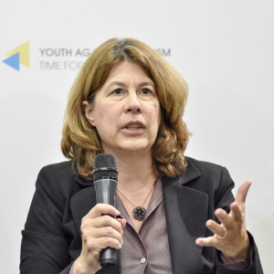
Dr. Lauren Van Metre is a non-resident senior fellow at the Atlantic Council’s Eurasia Center. She is also senior advisor for peace, security, and democratic resilience at the National Democratic Institute, having worked on major conflict resolution and prevention initiatives at the Pentagon, the State Department, and the US Institute of Peace. Dr. Van Metre is a leading expert on community resilience to violence; she has conducted research and led field initiatives on building the strength and capacity of communities to resist violent actors and recover from the shock of violence.

John Boerstler is chief executive of Combined Arms, which champions innovative approaches to veterans’ reintegration into civilian life. John’s experience as a service member in the US Marine Corps and personal commitment to build community through connecting veteran service organizations led him to public service, and as the CEO of Combined Arms, he is focused on the “Why?” behind the organization-bringing each consideration back to the core mission. His purpose is to sure that all veterans can unite with their communities to provide long lasting economic impact.
Acknowledgments
The authors of this report would like to thank Ella Lamakh, President of the Democracy Development Center, Kyiv, and Maria Dmytrieva, gender specialist of of the Democracy Development Center, Kyiv, for their expertise on veterans issues and for organizing interviews with other critical advocates. Their input and recommendations have been invaluable. We would also like to recognize Ambassador Steven Steiner, retired, for his unwavering support for the people of Ukraine, especially those impacted by Russia’s invasion of the Donbas, the internally displaced and the veterans of the war. The Atlantic Council’s Eurasia Center would like to thank Michael Newton for his invaluable work on this project.

The Eurasia Center’s mission is to promote policies that strengthen stability, democratic values, and prosperity in Eurasia, from Eastern Europe in the West to the Caucasus, Russia, and Central Asia in the East.
Image: Veterans and their relatives attend a ceremony to commemorate Ukrainian servicemen, who were killed during a military conflict near the town of Debaltseve in the east of the country in 2015, in Kiev, Ukraine, February 18, 2017. REUTERS/Valentyn Ogirenko
